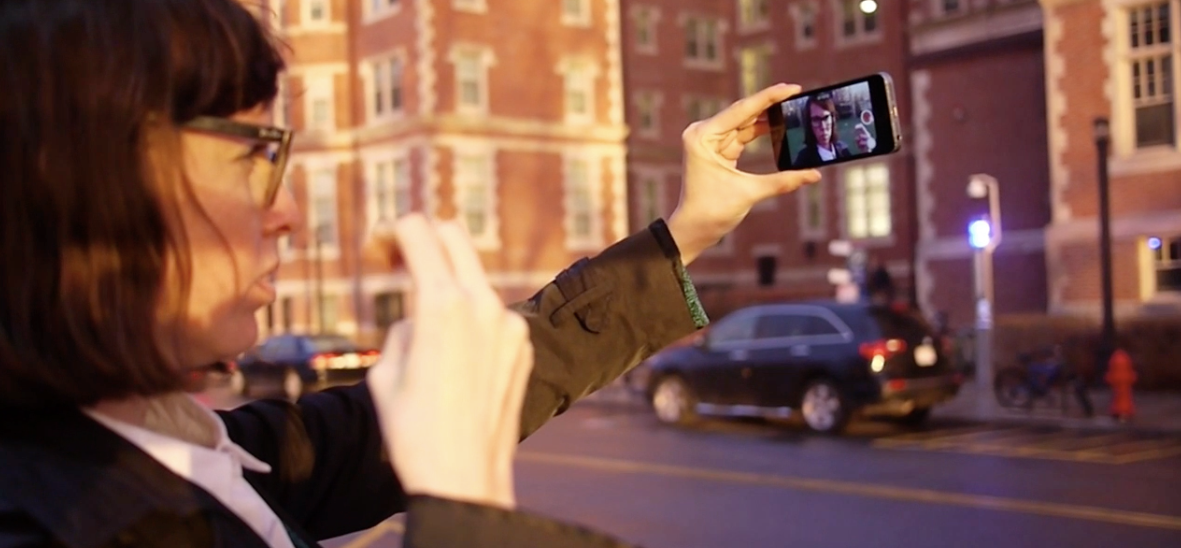
A usability test participant learns the sign for "bus" while waiting for the bus on her way home from school.
Background
This is an individual project I began working on as an Apprentice in User Experience at Fresh Tilled Soil, a Boston-based digital design agency.
Challenge
While gamified lesson plans are an effective and engaging way to learn for many, I wanted to explore alternatives to this format where material is learned more organically, is more freely and meaningfully associated, and is unique to every learner. I chose to design an experience for learning American Sign Language, other than my personal interest in learning it, because I was intrigued by the potential challenges it poses and opportunities it may afford compared to a hands-free, oral language. With American Sign Language is also a rich culture to immerse yourself in and diverse communities of hearing, hard of hearing, and deaf individuals to connect with.
Approach
I approached this project through iterative design sprints consisting of five phases:
- Understanding user needs and motivations
- Diverging to generate many ideas
- Converging on one idea
- Prototyping the core user flow
- Testing my most dangerous assumptions
Sprint 1
Understand
During the initial sprint, I wanted to better understand people’s motivations behind learning another language and explore what patterns of studying behaviors existed. Through interviews, I discovered that people were studying in shorter, more frequent sessions, on the go, and often times spontaneously rather than following a structured study schedule.
Diverge
I began sketching ideas for short, engaging learning exercises and ways to capture moment-of-learning associations, such as what the user was doing, where she was, or how she was feeling during those exercises. Referred to as “hints”, these associations would always remain attached to the words, serving as memory aids when needed.
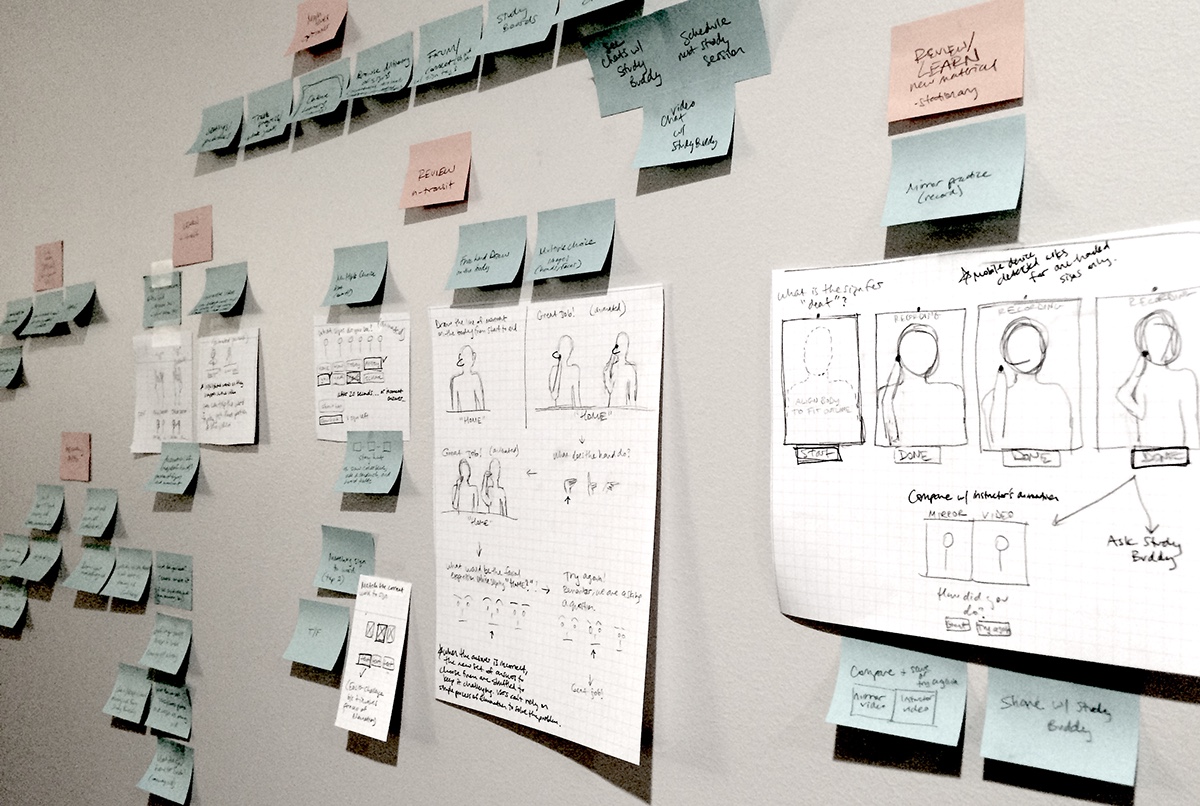
Grouping key information from user interviews and sketching ideas.
Converge
The core user flow began with learning the sign for a word, then adding a hint, and finally seeing that hint available during review exercises.
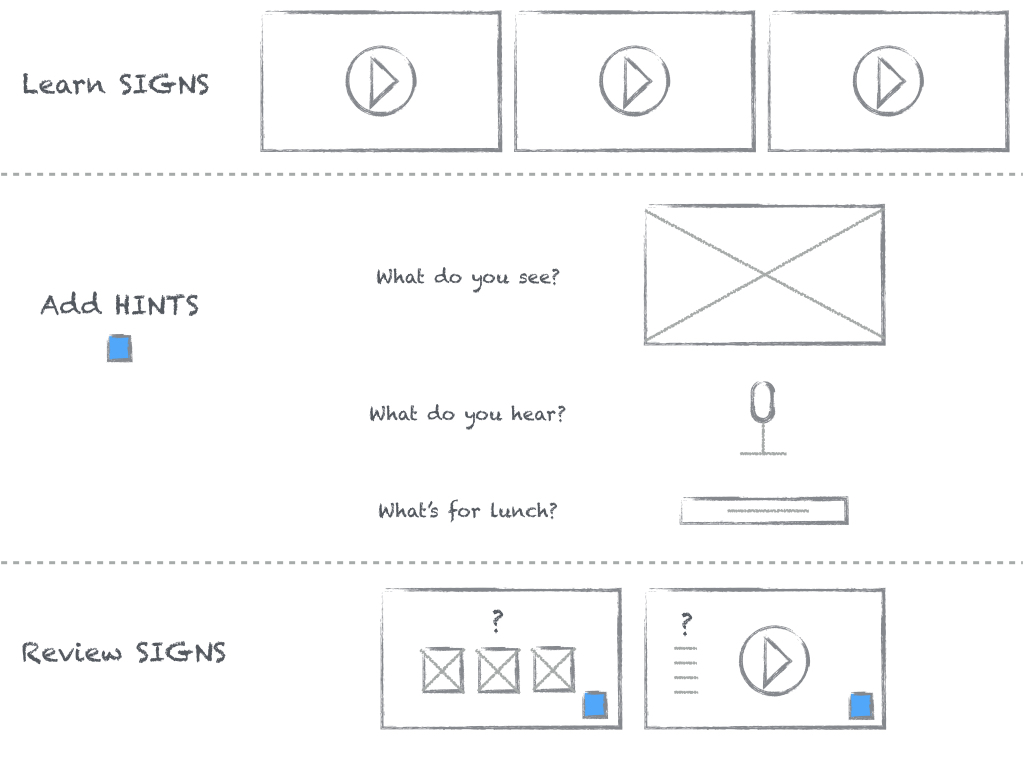
A diagram of the initial most important user story.
Prototype
Starting with paper prototypes, I moved to Keynote so that I could include videos of words being signed. Keeping this prototype at low-fidelity allowed me to test my assumptions and get the most valuable feedback regarding core user flow rather than specific features or details for UI design.
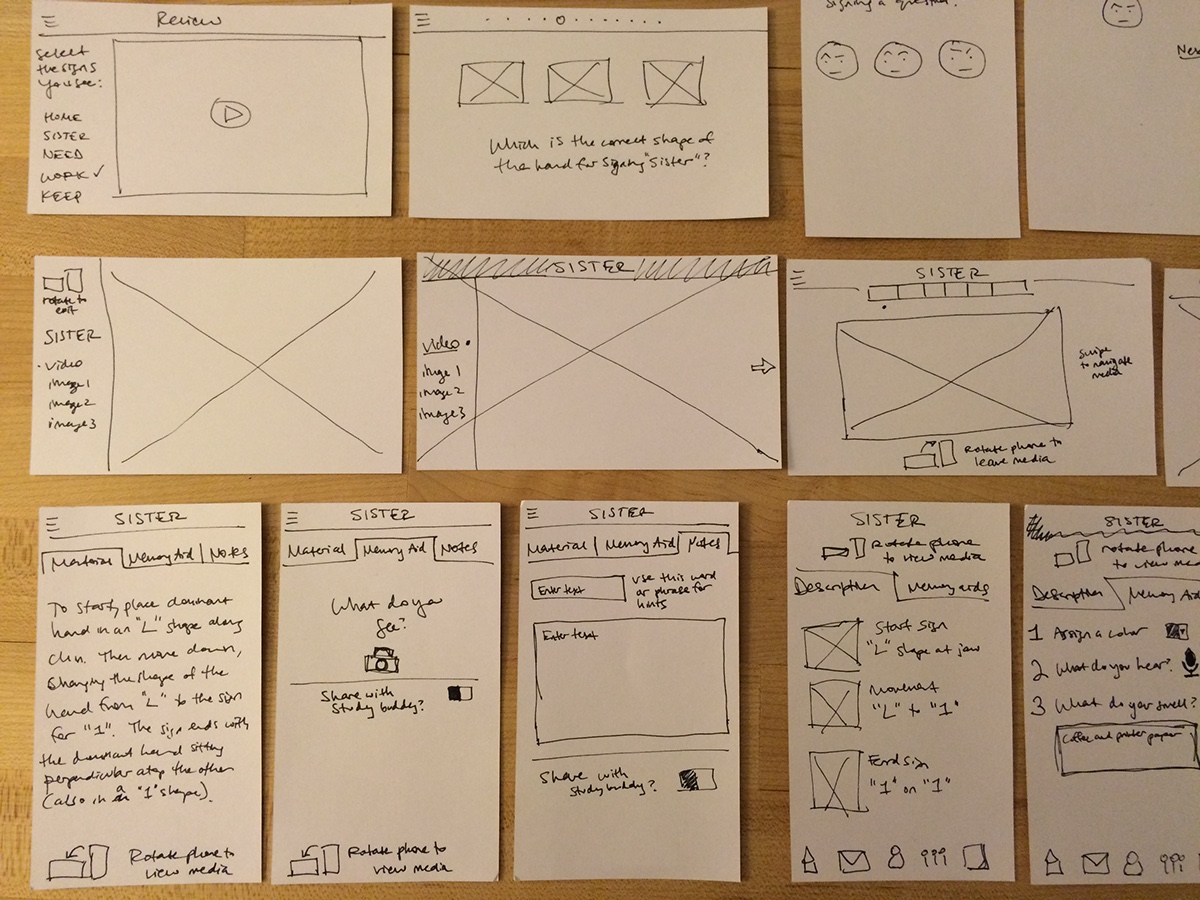
Paper prototyping ideas.
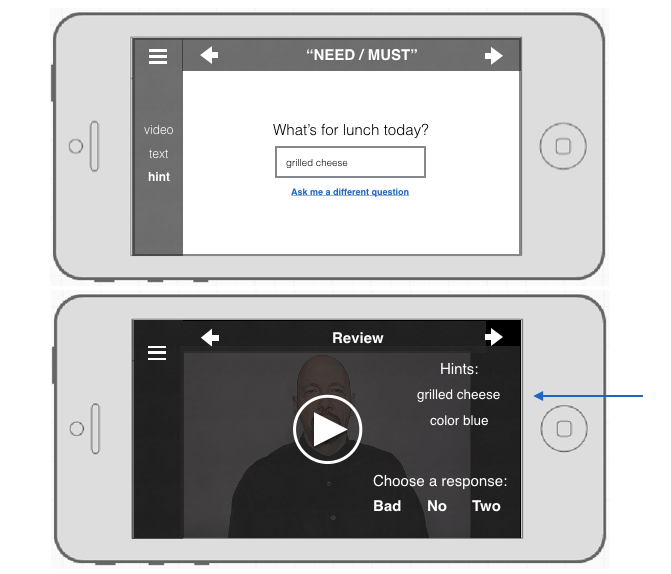
Screens from low-fidelity prototype to test idea for creating and using hints.
Test
Method
The most dangerous assumption I wanted to test here was that users would find it engaging and useful to associate each new sign they learned with something specific about the moment they learned it.
I recruited five participants with no prior experience learning American Sign Language. Simply because of time constraints, this test was conducted remotely using Keynote and video/voice chat.
Participants were asked to think aloud while they used the prototype to learn new signs and complete review exercises. Because I was moderating, observing, listening for what participants were and weren’t saying, and taking notes, each session was also recorded with the participant’s consent.
Findings
Overall, participants were confused by the idea of explicitly choosing an association to make with certain signs. Referring to them as "hints" and "memory aids" increased confusion, as participants expected that the hint would directly relate to the actual meaning of the sign rather than relate back to the moment they learned the sign. Every participant wanted more flexibility with creating hints, mainly the ability to take notes and draw.
Further insight
Attempting to measure how well people were remembering signs they had learned using hints with just a handful of participants wasn't too effective. Particularly because of the confusion around what the hints were and how they were being used, it was much more valuable to simply hear their thoughts and observe their behaviors while testing the prototype.
In addition, this particular usability test would have been much more effective if it were conducted as a field study, which would allow participants to use real rather than simulated moment-of-learning experiences as associations.
Sprint 2
From the feedback, observations, and lessons learned in the first sprint, it only made sense to use this next sprint to test my next set of assumptions out in the real world, testing how people learn new signs and create hints at different times of day and in different types of environments.
Understand
I first wanted to better understand how people use spare time throughout a typical day. Through in-depth interviews, I recorded detailed accounts of each individual's experience throughout a specific day, including what they were feeling and thinking. I found that individuals used their lunch and commute time primarily to connect with close friends and family, sharing with others where they were, what they were doing, and how they were feeling.
Diverge
What if these moments of sharing with others were also used for learning new signs? What if the user is in control of the material she learns based on what she is doing, where she is, and how she is feeling? In learning signs relevant to what is going on in the user's life at that moment, the user no longer needs to rely on adding hints for creating moment-of-learning associations.
Converge
Instead of learning a pre-determined series of signs, the revised key user flow then begins with learning signs that are relevant to the user during that moment-of-learning.
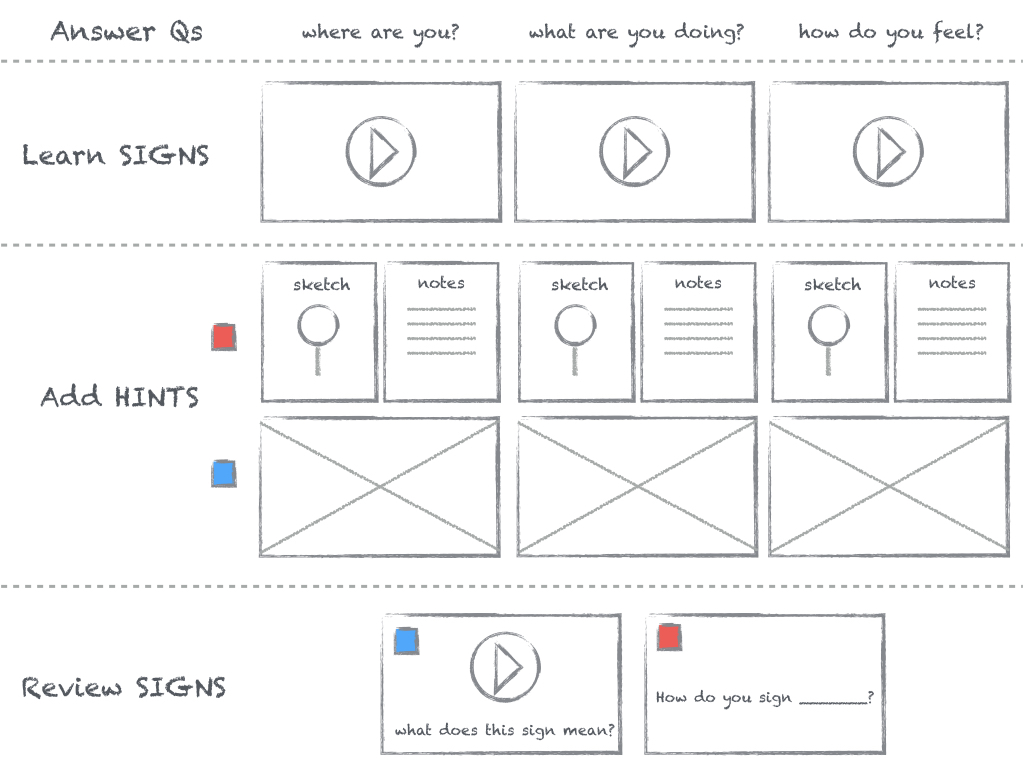
A diagram of the most important user story revised.
This was done by prompting the user to answer questions like "Where are you?", "What are you doing?", or "How do you feel?".
Adding hints becomes a practical way to help learn new signs in whatever format is most effective - notes, a sketch, image, or other media.

Wireflow of screens from low-fi prototype created to test which type of hint users rely on for remembering signs.
Prototype
From this wireflow, I created interactive prototypes with video layers using Flinto. Because I was still testing core user flow, I kept the fidelity level low. During usability testing, I gave participants paper prototypes for actually creating their hints.
Test
Method
The key assumptions I wanted to test were:
- Users will add hints for helping them remember the meaning of the sign.
- Users are more likely to create hints and capture their environment if the environment is interesting and at a more productive time of day (ie, morning or afternoon rather than at the end of the work day).
- Users will rely mostly on notes and sketches for remembering what signs mean when they are using the app during their commute, rather than take photos.
To do this, I observed four participants learning signs and creating hints while in different environments and times of day. The tests with participants A and B were divided into separate sessions on different days.
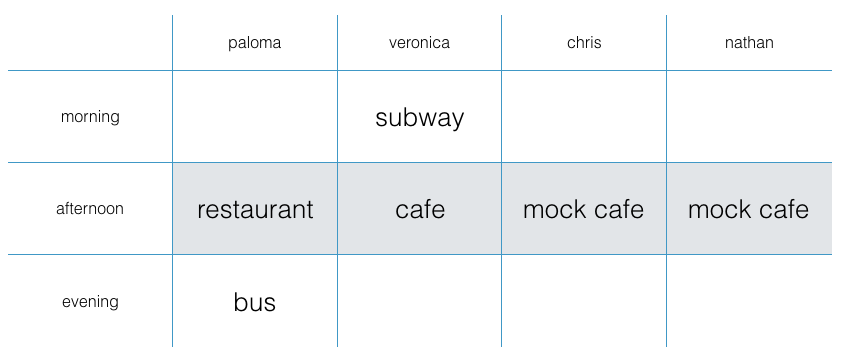
Table shows plan for usability testing. Paloma, Veronica, Chris, and Nate participated in the afternoon at a cafe, restaurant or mock cafe. In addition, Paloma participated in the evening on the bus, and Veronica participated in the morning on the subway.
For this usability testing, I teamed up with other apprentices for help with recording sessions and taking notes.
Findings
User-generated hints
Rather than add hints for helping them remember the meaning of the sign, most participants added hints for remembering how to sign the word they were learning.
Participants A, B and C created hints for remembering how to sign words. Participants A and B chose to describe hand shape and movement by drawing diagrams and adding notes. Participant C added detailed descriptions to describe hand shape and movement, in addition to drawing diagrams.
Only Participant D created hints for remembering what signs meant, using drawings and notes.

Paper prototypes showing the hints created by each participant.
Overall, participants seemed to prefer adding notes as their primary hint, regardless of how the hint was to be used and under what environmental conditions the moment-of-learning was.
Reviewing signs with user-generated and app-generated hints
In the second sessions with participants A and B, hints they created for signs they learned in the previous session were used to help them remember how to sign the word. When asked to recall the meaning of signs, they could see other words they learned at the same time and when or where they learned that group of signs.

Rough prototype created to test the use of app-generated and user-generated hints for helping Veronica remember the sign for "cafe".
Incorporating user-generated and app-generated hints in this way was easy for both participants to understand and use. Both participants were willing, but less excited, to take a photo of themselves signing or of their surroundings during their morning and evening commutes. Not surprisingly, both were more interested in taking photos while having lunch.
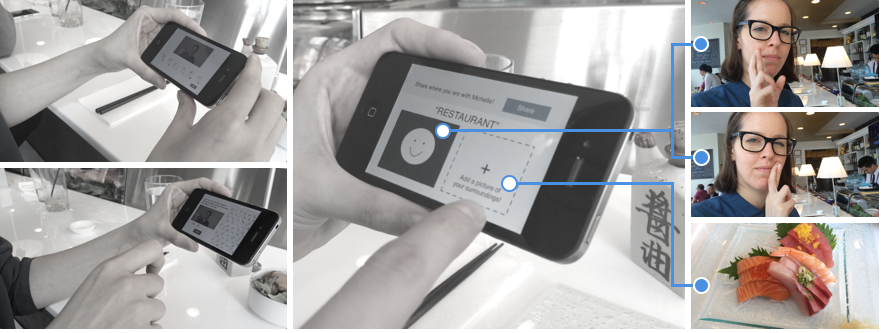
Paloma learning how to sign "restaurant" while eating lunch.
Further insight
All but one participant were willing to take photos of themselves or their surroundings, particularly in the afternoon at lunchtime. All but one participant developed strategies for taking photos/videos of themselves signing a two-handed sign. In other words, people were able to find a way to accomplish something if they were motivated enough to do so. However, having to prop your phone up against a cup of coffee at the table, or placing your phone temporarily on your lap while on a moving train isn't the best experience.
Other interesting findings were:
Participants expressed that they felt comfortable learning to sign in busy public environments because no sound was necessary.
Participants got left and right confused, some had much more trouble with this than others.
Participants had trouble initially learning a sign when presented by more than one person.
Participants enjoyed learning their names and seeing their names used throughout the prototype.
Sprint 3
The focus of the final sprint was to build on the exploratory findings of the previous sprints, redefining the core user flow to create a personalized language learning experience for real users.
Understand
I began research into who is practicing sign language, what their motivation is to learn/practice American Sign Language, and what their level of proficiency is. From this research, three key personas and an important user story that connects them emerged.

Personas with empathy maps for Just Learning Jill, Busy Cousin Ben, and Keeps Practicing Kate.
Ben and Jill
Ben is deaf and fluent in ASL. He enjoys making new friends, encourages anyone interested in strengthening their ASL skills, and is actively involved in the deaf community.
Ben frequently shares photos on Facebook and Instagram. His cousin Jill, in California, often comments on his social media posts in an effort to stay connected. Every so often, Ben and Jill will find time to video chat.
Jill is hearing and just beginning to learn American Sign Language in order to connect with Ben and the family more. She is very motivated to learn sign language in order to build a stronger relationship with her cousin.
While video chat enables Jill to learn and practice new signs with Ben as they would in person, she and Ben struggle to have meaningful conversation over what turns into a half hour tutoring session. Infrequent video chatting adds to the struggle, since Jill goes weeks without practice signing with another person.
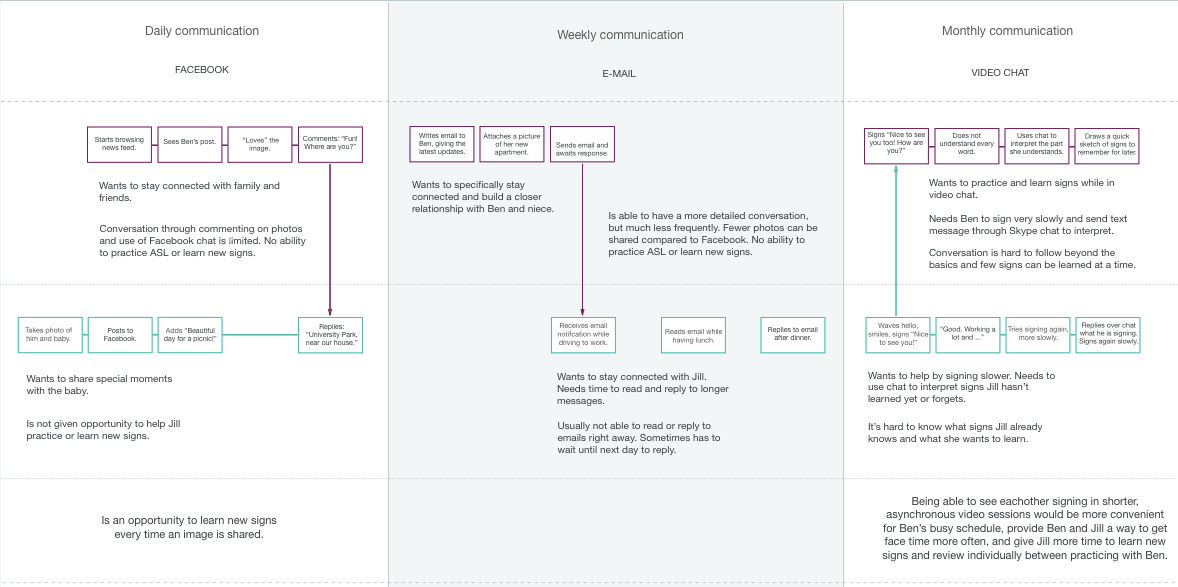
Experience map showing daily, weekly, and monthly communication between personas Jill and Ben.
In mapping the experience of daily, weekly, and monthly interactions between Ben and Jill, I was able to pinpoint opportunities for addressing specific pain points.
Ben and Jill frequently connect through sharing photos. Each time either shares a photo could be an opportunity for Jill to learn new signs and share what she is learning with Ben. With access to media created by users fluent in American Sign Language, Jill could describe the photo she is sharing with Ben using sign language. Having attached various signs to the description of her photo, she is able to review all of the signs she has learned, add notes and/or sketches, and more easily share what she is learning with others.
Kate
Kate is hard of hearing. On a weekly or monthly basis she meets with others to practice ASL and stay connected with the deaf community. Due to limited signing practice, however, she often finds it difficult to establish more meaningful relationships. She needs a way to more easily and more frequently connect with others in the community.
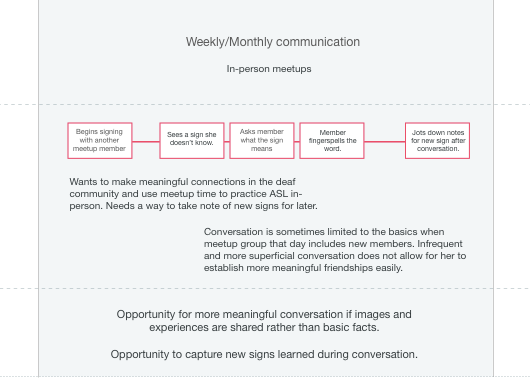
Experience map of Kate's weekly/monthly communication with others in the deaf community.
In mapping Kate's specific flow of interactions when practicing sign language in person, the key opportunities discovered were:
- Kate could have more meaningful conversations if photos were shared.
- She could more effectively learn new signs while in conversation if she could better capture them to practice later.
Diverge
How does the core user flow need to evolve to support each of these use cases for these key personas?
How does this inform the core functionality for the app?
Converge
A new core user flow that begins with the user taking a photo turns any moment a user wants to capture and share with others into a moment of learning. Signs are attached to the photo by adding a short description and hints can be added to each sign.
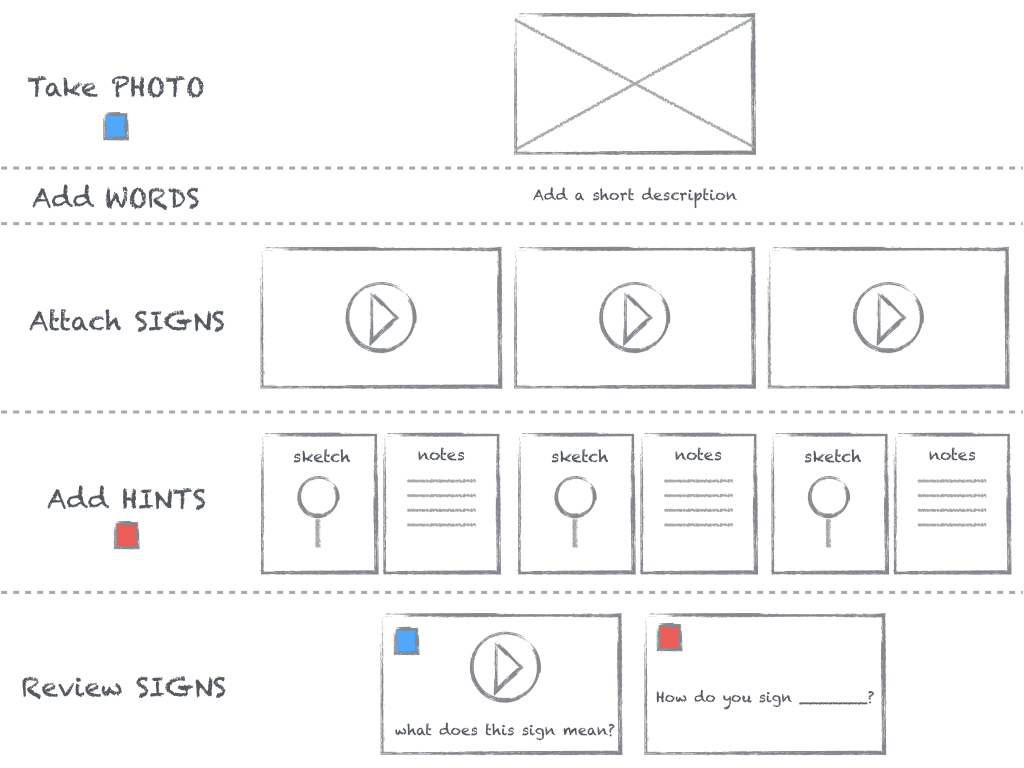
A diagram of the current most important user story.
Prototype
I began prototyping using Balsamiq Mockups for exploring UI designs before arriving at a design that best supported a learning experience centered around an image.

Prototype designed with Balsamiq illustrating core functionality.
I used the design I created in Balsamiq as a starting point for creating a higher fidelity prototype in Sketch, adding more detail to the core user flow, experimenting with the look and feel, and creating an interactive mockup of my Sketch app with InVision.
Video of interactive prototype created in Sketch and InVision shows adding an image, adding a description, and, for each word in the description, attaching a video of yourself or another user signing the word, as well as notes and/or a sketch for remembering how to sign each word.
Exploring my ideas without the use of a design system was great exercise in generating original designs for layout, look and feel, and navigation. I did, however, want to research and experiment with recreating a prototype using a design system. This resulted in a deep dive into Google's Material Design system, a new energy and perspective, and a well structured prototype with a more polished look and feel.
Using a list-based navigation, I designed three core content views to hierarchically structure all items, a single image item, and a sign item for an image item.
All items
When an already on-boarded user starts the application, she is given a list view of her previous entries with a floating action button to easily add a new one. Provided with this three-line list, she can search her images by description, see the number of signs and hints added, and sort by the item's date.
Image item
Selecting an image item allows her to view and edit the item's image, description, or signs. To drill down further to details for each sign, she selects a sign from the two-line list.
Sign items
In viewing sign details, she can add or edit her hints or media of the sign.
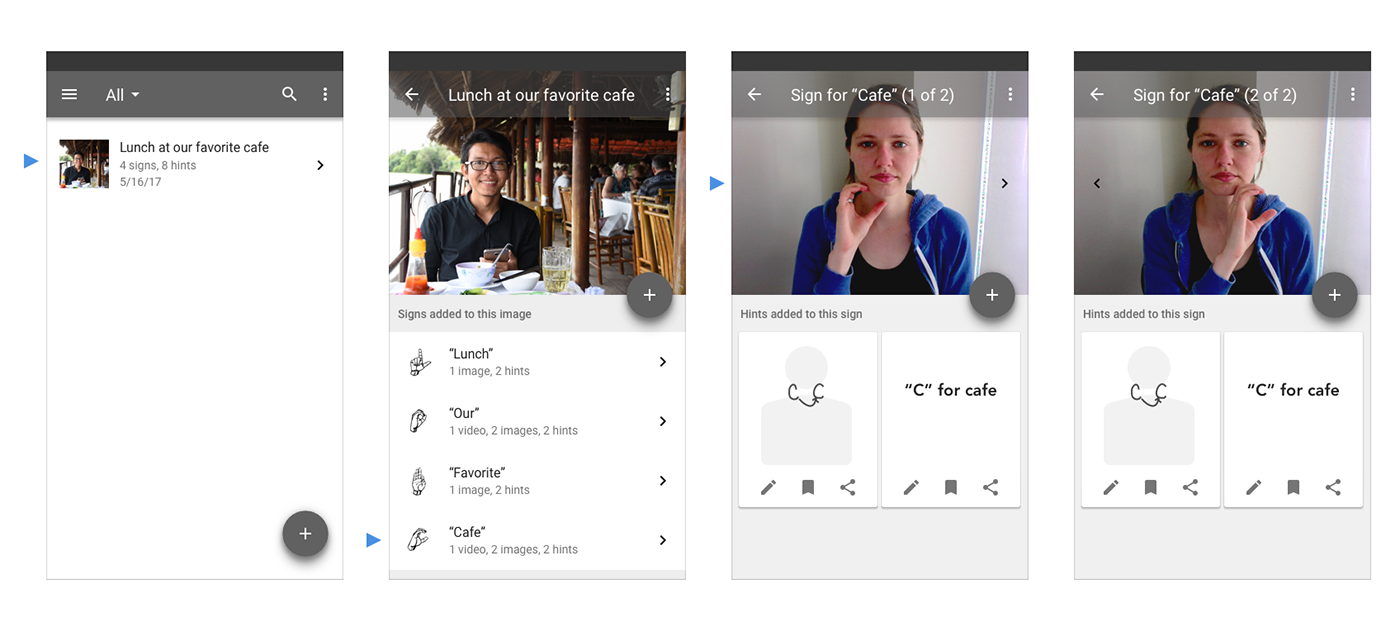
Screenshots from most recent prototype created with Sketch.
Reflection
During this project I fully immersed myself in every aspect of the design sprint process and used it to drive the design of a user experience, from concept to working prototype. It was an opportunity to apply design thinking principles in practice, and use insights from user research and testing to challenge and inform each iteration of design.
I made mistakes and learned many lessons along the way in each phase, but perhaps the most exciting discovery I made was during testing. I found that allowing time after a test session to openly discuss with the participant and follow up with any questions I had as an observer proved to be invaluable. Paired directly with testing my assumptions, having that dialogue not only helped in better understanding a user's motivations but also gain further insight I otherwise would have missed out on.
